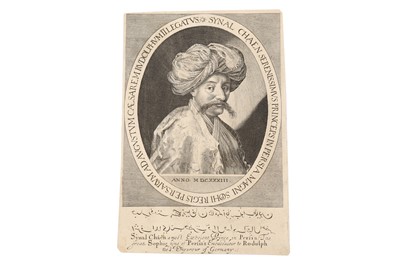29th Oct, 2020 13:00
Islamic & Indian Art
AN ENGRAVING WITH THE PORTRAIT OF SYNAL CHAEN BY AEGIDIUS SADELER II
Possibly Prague, Czech Republic, first half 17th century
AN ENGRAVING WITH THE PORTRAIT OF SYNAL CHAEN BY AEGIDIUS SADELER II
Possibly Prague, Czech Republic, first half 17th century
Black ink on laid watermarked paper, with 2ll. of inverted Persian script and 3ll. of English script, in an oval the half-length portrait of Sinal Khan Shamlu, the Persian ambassador of Shah Abbas I to the court of the Holy Roman Emperor Rudolf II, wearing a heavy, multi-folded turban and brocaded overcoat with male figures in the wilderness, following the fashion of Safavid textiles of the time, with long hairy moustaches, below him the year in Roman numerals 1633 (MDCXXXIII), around the oval the honorific Latin inscription Synal Chaen Serenissimus Princeps in Persia. Magni Sophi Regis Persarum ad Augustum Caesarem Rudolphum II Legatus, translated in English on the bottom of the page, the watermark in the centre of the page consisting of a single-handled pot surmounted by a floral spray with quatrefoil and crescent, 23.5cm x 15.2cm.
Engravings of Synal Chaen, such as ours, are part of several international museums' collections like the British Museum (inv. no. O,2.101), the Metropolitan Museum of Art (inv. no. 61.663.252) and the Rijksmuseum (inv. no. RP-P-OB-4995). The main differences between our lot and these engravings are the presence of an extra line above the date - cum priuil S. Cae. Mtis. - and the correct orientation of the Persian script, which in our example is inverted. The engravings in the museums' collections are usually attributed to the work of Aegidius Sadeler II, who was inspired by the work of Esaye le Gillon, a Flemish painter at the imperial court of Rudolf II in Prague during the early 17th century. Sadeler's engravings tend to date 1604. However, our lot is dated at least thirty years later, 1633, and this dating is confirmed also by the watermark of the laid paper used for the engraving. Indeed, although the watermark of the single-handled pot was already in use in the early 17th century, it wasn't until the 1630s and 40s that the motif became more complex like in our lot, including a more sumptuous floral spray, and the quatrefoil and crescent motifs at the same time, as evident in the Thomas L. Gravell Watermark Archive (https://www.gravell.org/).
Do you have an item similar to the item above? If so please click the link below to submit a free online valuation request through our website.


